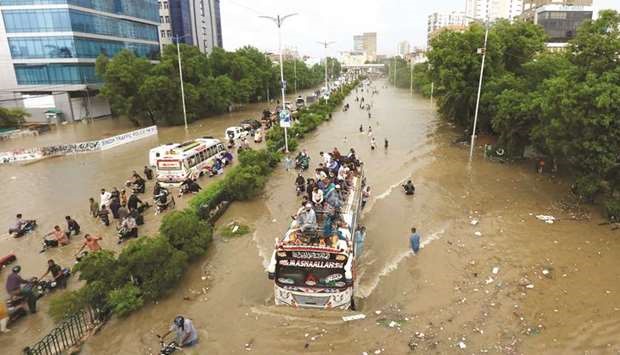It is easy to blame climate change for every calamity or environmental collapse. However, there are other disasters caused not due to extreme weather but unsustainability of planning and development. One of the recent examples is the case of urban flooding in Pakistan. Last year it hit Karachi in monsoon and this year in Islamabad, when an ecocatastrophe in the shape of rain-flood drowned both cities and exposed their developmental vulnerabilities.
Generally urban flooding causes due to the lack of drainage in a city. But in Pakistan, frenzied and unregulated construction, informal settlements, overburden drains and municipal waste mismanagement are major reasons of this havoc. The last two monsoon seasons are, in fact, eye-opener in this regard.
Flooding & Illegal Settlements in Karachi
First in Karachi on August 27, 2020 when torrential rain brought flooding in the downtown area and living almost paralyzed in the whole city. At least 30 people were died in the flood and an emergency was declared. The authorities blamed the informal settlements alongside Gujjar and Orangi Nullah which had decreased the width of the drains, however, it is a reality the dumping of garbage and industrial waste in Nullahs as well as encroachments over them didn’t allow the rainwater to flow out.
The Karachi city has more than 55% occupancy by slums and irregular settlements, which is definitely a big question mark on the urban planning of the megacity. But overlooking environmental regulations and urban hydrology even in mega projects is fairly a common practice, which can’t be ignored for urban flooding.
Islamabad Rain Flood & Encroachments
Similarly in Islamabad on July 27, 2021 an eight hour rain kept the life crippled in the federal capital with killing two people and destroying millions of rupees public properties and assets. The flood in Sector E-11 was created due to the encroachment by various unapproved Cooperative Housing Societies in E-11/2.
Sector E-11 is located in the heart of the city but dotted with unauthorized high-rise buildings and several illegal cooperative housing schemes. The natural drainage in the area had been squeezed down and also encroached upon by shopping plazas and homes in a ‘planned’ CDA designated area. The waste was being dumped in the tributaries and when water levels rose, the clogged and encroached upon drainage system gave way.
Concrete structures in catchment areas, encroachment on waterways and outdated drainage systems disrupt the flow of rainwater and causes flooding in cities. Besides overcrowding and unchecked migration in both metropolises can’t also be ruled out as contributors in these ecocatastrophe.
By
Editorial, Infocus


